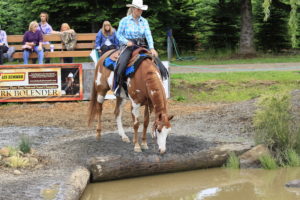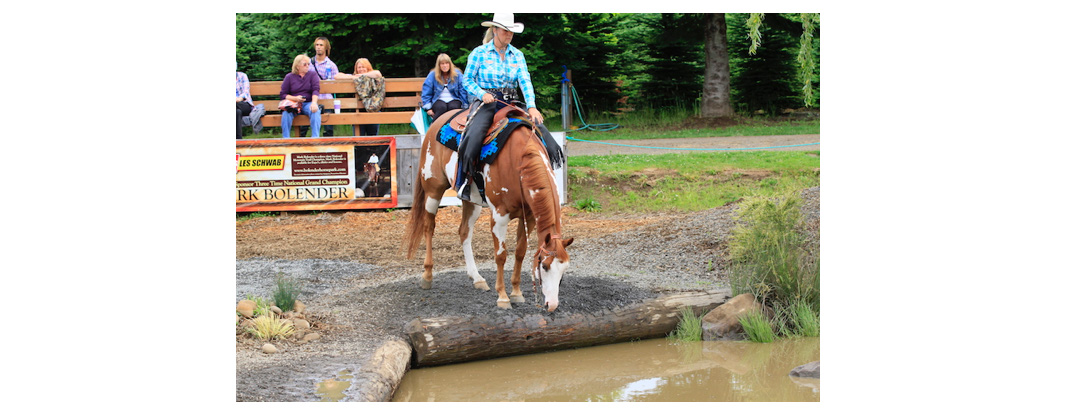Why Location and Setting Makes All the Difference to Your Horse
By Vickie Zapel

Your horse crosses anything, anywhere out on the trail, but when asked to negotiate a man-made obstacle, suddenly proceeds to turn himself inside out. What is going on here? This is a common and frustrating scenario that can only be solved if we look at it through the horse’s eyes. Let’s begin with a water crossing situation: a manufactured water box versus the usual stream you cross on the trail. Obviously, the horse sees these as very different situations and has his reasons for doing so.
The entire setting for a trail ride is in very natural surroundings, quite possibly a trail your horse has experienced before, or a flowing stream that had a similar entrance to the last stream you crossed uneventfully.
Probably you were with friends and your horse considered their horses to be part of his herd while riding. In his mind there is always safety in numbers. Your trusty steed may have had concerns about the water crossing, but was content to follow the horse tail in front of him through the muck and wet—how bad could it be when the rest of the herd is crossing? So, why not ride him right up to that man-made water box and ask him to immediately commit and step in?

First, the horse knows this is NOT a natural object. It does not look or smell the same, there is no natural trail leading to the entrance, his trail buddies are not with him for herd support and it is more difficult for him to understand the bottom of the obstacle which makes his instincts kick in and tell him he could break a leg. It makes absolutely no sense to a smart horse that sees it would be much easier and safer to simply walk around the edge of the obstacle. Instead, you are insisting he step into the man-made box at his own peril.
Begin by viewing the refusal to enter the man-made water box as a beneficial experience because it means you have some holes in your training; the sooner you recognize that the better. Going back to basics is always an excellent way to fix things. Consider running a garden hose in the driveway where you can easily walk or lunge your horse directly through a large, safe, wet spot. When he no longer shows signs of anxiety, begin maximizing the difficulty in small increments such as including additional items, one at a time. Add a few rocks, tree limbs, poles, plastic, a sprinkler, etc., You are only limited by your imagination, just remember to keep it safe. If you frighten your horse with your embellished obstacles, you’ll be proving him right about being leery of an unfamiliar obstacle. Let your horse set the pace in this scenario. Ultimately, your goal is to build a solid foundation for his trust and confidence in your leadership; this is best accomplished in drama-free increments.
Realize that every horse is different. Much will depend on his past experiences, (which he never forgets), his ability to decipher the information you present, how often and consistently you are willing to work with him and your own level of training abilities. Another way to work with him is to utilize an empty ditch in sensible surroundings. A ditch works great because the horse has to step down into it. Start with a shallow location initially, and then add the garden hose. Eventually, increase the difficulty to a location that is steeper and deeper. Finally, add some of trail debris on one side of the ditch, after the water is no longer an issue. You get the idea. Set your horse up for success and soon entering such obstacles will become his idea.
When you approach the man-made water box—or any obstacle—be certain that you are asking your horse to perform at a level acceptable for his training and experience. If your horse is only halfway through kindergarten, don’t make him distrust you by giving him a high school quiz. It isn’t fair and won’t build a solid foundation or mutual trust agreement.
Indicators that your horse is not ready to enter an obstacle can be displayed in many forms: refusal to even face the obstacle, moving from one side to another, attempting to turn around and backing away. Do not allow your horse to complete any of his refusal maneuvers. Even if you are not prepared to enter the obstacle, keep him pointed straight at the entrance spot and let him “settle his mind” while in position. When he becomes calmly focused and inquisitive of the obstacle you can assert the appropriate cues for him to move forward.
Vickie Zapel is a certified professional riding instructor who teaches competitive trail for the Equine Studies Institute of Breyer University. The winner of multiple awards, she has always trail ridden her show horses. Vickie is devoted to promoting mountain trail training; nothing is better for any discipline of riding or breed. For more information visit ridecompetitivetrail.com.
Published May 2014 Issue

The Colorado Horse Source is an independently owned and operated print and online magazine for horse owners and enthusiasts of all breeds and disciplines in Colorado and surrounding area. Our contemporary editorial columns are predominantly written by experts in the region, covering the care, training, keeping and enjoyment of horses, with an eye to the specific concerns in our region.

